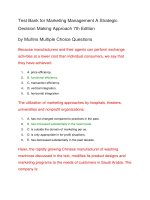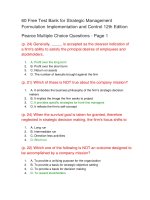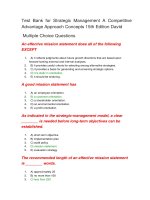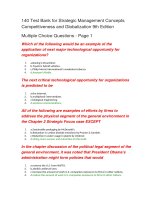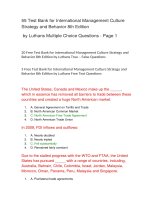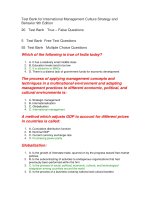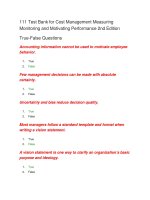Test bank for cost management measuring monitoring and motivating performance 2nd edition
Bạn đang xem bản rút gọn của tài liệu. Xem và tải ngay bản đầy đủ của tài liệu tại đây (204.03 KB, 37 trang )
Test Bank for Cost Management Measuring Monitoring and
Motivating Performance 2nd Edition
Which of the following often prevents managers from adequately exploring
information before making a decision?
1. a. The existence of many uncertainties
2. b. The need to distinguish between relevant and irrelevant information
3. c. The managers’ biases
4. d. The organization’s values
Irrelevant information may be I. Useful in decision making II. Internallygenerated III. Accurate
1. a. I only
2. b. I and II only
3. c. II and III only
4. d. I, II, and III
Whether a given type of information is relevant or irrelevant depends on
1. a. Its accuracy
2. b. Its objectivity
3. c. Its relation to the decision to be made
4. d. Whether it is cash-basis or accrual-basis
Relevant cash flows are
1. a. Past cash flows
2. b. Future cash flows
3. c. Incremental cash flows
4. d. Unavoidable cash flows
In a decision to lease or borrow money and build office space, which of the
following is relevant?
1. a. The current cost of office space
2. b. The architect’s fee for drawing the building
3. c. The number of employees currently working for the company
4. d. The personal preferences of the decision makerA$2
Irrelevant cash flows are
1. a. Avoidable
2. b. Unavoidable
3. c. Objective
4. d. Subjective
Relevant cash flows are
1. a. Avoidable
2. b. Incremental
3. c. Both of the above
4. d. None of the above
Frank is considering transportation modes to a client’s office. He can drive his
own car, at an incremental cost of $0.55 per mile, or take a company car. If he
takes his own car, he can be reimbursed $0.45 per mile. If Frank makes his
decision strictly from his personal economic point of view, what is the
relevant net cost associated with driving his own car?
1. a. $0.10
2. b. $0.45
3. c. $0.55
4. d. Some other amount
As an accountant, you are responsible for I. Your own behavior II. The
behavior of any organizations you manage III. The behavior of outside
vendors with whom you interact
1. a. I only
2. b. I and II only
3. c. I and III only
4. d. I, II, and III
When is the most appropriate time to identify ethical problems in
organizations?
1. a. When they are discovered by legal authorities
2. b. As they arise
3. c. After they arise
4. d. When they are discovered by shareholders
Conflicts of interest often compromise managers’ ability to make ethical
decisions. Which of the following situations most likely includes a conflict of
interest?
1. a. Selling goods and services at discounted prices to some clients based on
historical volumes
2. b. Offering sales on credit only to creditworthy clients
3. c. Paying dividends to shareholders rather than investing in an environmental
project
4. d. Using LIFO to report the cost of ending inventory on the balance sheet
Rewards for ethical behavior can include I. Integrity II. Reputation III. Higher
profits
1. a. I, II, and III
2. b. I and III only
3. c. I and II only
4. d. II only
Which of the following can influence ethical behavior in organizations? I.
Employee personal values II. Systems for measuring, monitoring and
motivating III. Organizational culture
1. a. I only
2. b. I and II only
3. c. I and III only
4. d. I, II, and III
Fraudulent financial reporting I. Is an example of unethical behavior II.
Eventually is likely to decrease organizational market value III. Decreases the
value of the accounting profession
1. a. I only
2. b. II only
3. c. I and III only
4. d. I, II, and III
Decision quality
1. a. Refers to a decision that had a positive outcome
2. b. Refers to the characteristics of a decision that affects the likelihood of
achieving a positive outcome
3. c. Is reduced by uncertainty and bias
4. d. Both (b) and (c) are correct
Which of the following statements is false?
1. a. Managers must determine the organizational vision before further planning
can occur
2. b. Organizational strategies should take advantage of the organization’s core
competencies
3. c. Operating plans are long-term in nature
4. d. Organizational core competencies are an organization’s strengths relative
to competitors
Which of the following statements is true?
1. a. Managerial accounting and cost accounting are the same thing
2. b. Managerial accounting prepares reports used most frequently by external
decision makers
3. c. Cost accounting information is used for both management and financial
accounting
4. d. Preparation of the entity’s income tax return is an example of a cost
accounting activity
All of the following are examples of external reports except:
1. a. Tax returns
2. b. Credit reports
3. c. Financial statements
4. d. Budgets
All of the following are examples of internal reports except:
1. a. Cash flow analyses
2. b. News releases
3. c. Analyses of supplier quality
4. d. Product mix analyses
If a manager is deciding whether to repair equipment or replace it, which of
the following is irrelevant to the decision?
1. a. Cost of the repair
2. b. Original cost of the equipment
3. c. Warranty period for the repair
4. d. Expected life of the equipment if it is not repaired
Lori is deciding whether to go to school full-time at the local community
college or get a full time job. Which of the following is not relevant to her
decision?
1. a. Tuition costs
2. b. Potential salary she could earn in a full-time job
3. c. Cost of books
4. d. Monthly rent on her apartment
Relevant cash flows are
1. a. Unavoidable
2. b. Incremental cash flows
3. c. Constant across alternatives
4. d. Those that occurred in the past
Which of the following is not one of the steps in ethical decision making?
1. a. Identify the ways you might get caught doing something unethical
2. b. Identify the stakeholders to the decision
3. c. Identify the ethical dilemma
4. d. Identify the effects of the decision on the stakeholders
Which of the following statements is false?
1. a. Strategic cost management focuses on reducing costs as well as
strengthening an organization’s strategic position
2. b. The balanced scorecard is a formalized approach to strategic cost
management
3. c. The balanced scorecard may include both financial and nonfinancial
measures
4. d. Cost accounting information used for strategic cost management includes
only measures of costs
An internal report is
1. a. Used for decision making primarily inside the organization
2. b. Used for decision making primarily outside the organization
3. c. Used to explain new personnel policies
4. d. Used by financial analysts
Cost accounting is all of the following except
1. a. A process of gathering and summarizing information
2. b. Preparing employee evaluation reports
3. c. Preparing information for internal reporting and decision making
4. d. Preparing information used in financial statements
Financial accounting is all of the following except
1. a. A process of gathering and summarizing information primarily for external
reports
2. b. Preparing financial statements according to Generally Accepted Accounting
Principles
3. c. Information used by shareholders, creditors, and regulators for decision
making
4. d. Preparing information for internal reporting and decision making
Decision quality can best be increased by
1. a. Thinking harder
2. b. Controlling for bias and uncertainties
3. c. Asking an expert for help
4. d. Using the most current technology
Biases are
1. a. Necessary for decision making
2. b. Expert opinions
3. c. Ideas that are adopted without careful thought
4. d. Always part of decision making
Uncertainties are
1. a. Issues about which we have doubt
2. b. Foreseeable factors
3. c. Not usually part of decision making
4. d. Biased information
Relevant information
1. a. Plays no part in decision making
2. b. Varies with the action taken
3. c. Must be based on the opinion of experts
4. d. Is the same as unavoidable cash flows
Avoidable cash flows are
1. a. Usually relevant to a decision
2. b. Cash flows that are incurred no matter which action is taken
3. c. Ignored in decision making
4. d. Are the same as irrelevant cash flows
Ethical decision making
1. a. Does not include ongoing improvement
2. b. Considers the well-being of those affected by the decision
3. c. Has little to do with professional reputation
4. d. Is not important for accountants
The incremental cash flow approach
1. a. Analyzes the additional cash inflows and outflows for a specific decision
2. b. Is not useful for decision making
3. c. Is a search for as many cash flows as possible so they can all be used in
decision-making.
4. d. Includes unavoidable cash flows
Strategic cost management focuses on all of the following except
1. a. Strengthening an organization’s strategic position.
2. b. Reducing costs
3. c. Both financial and non-financial measures
4. d. Producing financial statements
Information for decision making
1. a. Is only produced inside an organization.
2. b. Includes estimates and predictions
3. c. Ensures certainty in the decision making process
4. d. Is easy to identify
Cost accounting differs from financial accounting in that cost accounting
is
1. a. Primarily concerned with income determination
2. b. Relied on for analyzing and implementing internal decisions
3. c. Focused only on qualitative information
4. d. Primarily concerned with external reporting
Tom is gathering information about buying a new car to replace his existing
car. The following items are irrelevant
1. a. The purchase price of the new car
2. b. The gasoline mileage of the new car
3. c. The cost of parking at the university
4. d. The money Tom will receive for selling the old car
Lisa would like to start a new business selling pet toys to local pet shops. To
reduce her uncertainty about the volume of toys she can sell in a month, she
should do all of the following except
1. a. Ask pet store managers how many pet toys they sell every month
2. b. Determine the average price of the pet toys sold each month at local pet
stores
3. c. Take a sample of toys to local stores and ask how many of each item the
managers would be willing to buy
4. d. Produce as many toys as possible the first month to be certain she has
enough
(CMA) When comparing strategic planning with operational planning, which
one of the following statements is most appropriate?
1. a. Strategic planning is performed at all levels of management
2. b. Operational planning results in budget data
3. c. Strategic planning focuses on authority and responsibility
4. d. Operational planning is long-range in focus
(CMA) Wong Company utilizes both strategic planning and operational
budgeting. Which one of the following items would normally be considered in
a strategic plan?
1. a. Setting a target of 12 percent return on sales
2. b. Maintaining the image of the company as the industry leader
3. c. Setting a market price per share of stock outstanding
4. d. Distributing monthly reports for departmental variance analysis
Maude’s actual operations would probably include
1. a. Establishing a sales strategy
2. b. Purchasing advertisements in local media
3. c. Identifying her core competencies
4. d. Developing a budget
Which of the following statements is true for Maude’s business regarding
measuring and monitoring performance?
1. a. Maude does not need a system to measure and monitor performance
because her company is a sole proprietorship
2. b. Maude needs audited financial statements every year
3. c. Maude can track cash flows on a monthly basis
4. d. Maude only needs to reconcile her accounts every few years
Belief systems are an important part of what framework?
1. a. Levers of information
2. b. Levers of control
3. c. Levers of belief
4. d. Control systems
The code of conduct of a firm would likely be considered
1. a. Belief system
2. b. Boundary system
3. c. Diagnostic control system
4. d. Interactive control system
Accounting information I. Can be used to guide organizational vision II. Is a
core competency for most companies III. Can be used to motivate
performance
1. a. I only
2. b. I and II only
3. c. I, II, and III
4. d. I and III only
Cost accounting information is used for
1. a. Financial reporting only
2. b. Management reporting only
3. c. Both financial and management reporting
4. d. Neither financial nor management reporting
Which of the following is a type of external report produced by an
organization’s information system?
1. a. Cash flow plan
2. b. Analysis of potential acquisition
3. c. News release
4. d. Bonus computations
Which of the following is least likely to be an external report?
1. a. Credit report
2. b. Supplier’s inventory report
3. c. Tax return
4. d. Analysis of supplier quality
Which of the following is the best example of an internal report that might
come from an organization’s information system?
1. a. Environmental Protection Agency regulatory report
2. b. Operating budget
3. c. Income tax returns
4. d. Medicare cost report
Financial statements are
1. a. External reports produced from an organization’s information system
2. b. Never used for internal decision making
3. c. Only true when they are audited
4. d. Unimportant reports for most organizations
Information gathered outside the organization includes
1. a. Customer preferences
2. b. Product design specifications
3. c. Taxable income
4. d. Number of employees hired
Which of the following is not true about information in an organization’s
databases?
1. a. Information may be collected formally or informally
2. b. Access to database information is often restricted to specific individuals
3. c. Intellectual capital is usually captured in database information
4. d. The benefits of generating information should exceed the costs
How does the use of sophisticated information systems affect strategic
managementerial decision making?
1. a. Sophisticated information systems always improve strategic
managementrial decision making
2. b. Sophisticated information systems always provide better information
3. c. Managers may overlook potential uncertainties and bias in their
information
4. d. The cost of sophisticated information systems may exceed their benefit
Irrelevant information may be I. Useful in decision making II. Internallygenerated III. Accurate
1. a. I only
2. b. I and II only
3. c. II and III only
4. d. I, II, and III
Whether a given type of information is relevant or irrelevant depends on
1. a. Its accuracy
2. b. Its objectivity
3. c. Its relation to the decision to be made
4. d. Whether it is cash-basis or accrual-basis
Relevant cash flows are
1. a. Past cash flows
2. b. Future cash flows
3. c. Incremental cash flows
4. d. Unavoidable cash flows
In a decision to lease or borrow money and build office space, which of the
following is relevant?
1. a. The current cost of office space
2. b. The architect’s fee for drawing the building
3. c. The number of employees currently working for the company
4. d. The personal preferences of the decision maker
Irrelevant cash flows are
1. a. Avoidable
2. b. Unavoidable
3. c. Objective
4. d. Subjective
Relevant cash flows are
1. a. Avoidable
2. b. Incremental
3. c. Both of the above
4. d. None of the above
Frank is considering transportation modes to a client’s office. He can drive his
own car, at an incremental cost of $0.55 per mile, or take a company car. If he
takes his own car, he can be reimbursed $0.45 per mile. If Frank makes his
decision strictly from his personal economic point of view, what is the
relevant net cost associated with driving his own car?
1. a. $0.10
2. b. $0.45
3. c. $0.55
4. d. Some other amount
UncertaintiesBusiness Risks
1. a. Are issues about which managers have doubts
2. b. Do not impact accounting information, which is highly objective and
reliable
3. c. Are preconceived notions developed without careful thought
4. d. Are rarely a problem in business decision making
Alaska Airlines flies several non-stop flights daily between Los Angeles and
Vancouver. Which of the following is a business risk associated with this
operation?
1. a. The exact number of flights flown the previous day
2. b. The average number of passengers on each flight the previous week
3. c. The average number of empty seats for flights next month
4. d. The number of ticket agents scheduled for each shift for the next day22.
Biases
Biases
1. a. Are issues about which managers have doubts.
2. b. Do not impact accounting information, which is highly objective and
reliable
3. c. Are preconceived notions developed without careful thought
4. d. Are rarely a problem in business decision making
UncertaintyBusiness risk may hinder a manager’s ability to: I. Adequately
define a problem II. Identify all potential solution options III. Predict the
outcome of various solution options
1. a. I and III only
2. b. II and III only
3. c. I, II, and III
4. d. II only
Pet Snacks Company has 500 pounds of liver-flavored dog biscuits that are
not selling well. The selling price of the biscuits could be reduced from $3.00
to $2.50 per pound. Or, they could be cheese-coated and sold for $4.00 per
pound; the additional processing cost would be $0.50 per pound. Cheesecoated biscuits sell very well. Which alternative probably has less uncertainty
concerning volume of sales?
1. a. Reduce the price of liver-flavored biscuits
2. b. Proceed with the cheese coating
3. c. Both alternatives are equally uncertain
4. d. Uncertainty does not affect this decision
Alaska Airlines flies several non-stop flights daily between Los Angeles and
Vancouver. Which of the following is an uncertainty associated with this
operation?
1. a. The exact number of flights flown the previous day
2. b. The average number of passengers on each flight the previous week
3. c. The average number of empty seats for flights next month
4. d. The number of ticket agents scheduled for each shift for the next day
Marriott Corporation operates hotels all over the world. Which of the
following is the best example of a potential bias associated with its
operations?
1. a. Managers assume that most travelers are interested in conducting
business, rather than vacationing
2. b. Managers learn that guests rarely stay longer than a week
3. c. Managers find that last year’s profits were below the industry average
4. d. Managers are concerned because employee turnover increased during the
last year
Uncertainties and bBiases can affect I. Organizational vision II. Core
competencies III. Operating plans
1. a. I only
2. b. II only
3. c. I and III only
4. d. I, II, and III
Which of the following statement about biases is true?
1. a. Biases can affect management accounting information, but not financial
accounting information
2. b. Managers cannot work toward eliminating their biases
3. c. Biases reduce the quality of decisions
4. d. Biased managers are more likely to explore alternatives before making a
decisionA$$3
Uncertainty may hinder a manager’s ability to: I. Adequately define a problem
II. Identify all potential solution options III. Predict the outcome of various
solution options
1. a. I and III only
2. b. II and III only
3. c. I, II, and III
4. d. II only
Biases may be
1. a. Intentional
2. b. Unintentional
3. c. Both intentional and unintentional
4. d. Beneficial to decision making
Biases
1. a. Inhibit anticipating all future conditions
2. b. Assist in the identification of relevant information
3. c. Do not affect the ability to identify irrelevant information
4. d. Are not a problem in ethical decision making
Pet Snacks Company has 500 pounds of liver-flavored dog biscuits that are
not selling well. The selling price of the biscuits could be reduced from $3.00
to $2.50 per pound. Or, they could be cheese-coated and sold for $4.00 per
pound; the additional processing cost would be $0.50 per pound. Cheesecoated biscuits sell very well. Which alternative probably has less uncertainty
concerning volume of sales?
1. a. Reduce the price of liver-flavored biscuits
2. b. Proceed with the cheese coating
3. c. Both alternatives are equally uncertain
4. d. Uncertainty does not affect this decision
Biases
1. a. Are issues about which managers have doubts.
2. b. Do not impact accounting information, which is highly objective and
reliable
3. c. Are preconceived notions developed without careful thought
4. d. Are rarely a problem in business decision making
Managers can make higher-quality decisions by relying on all of the following
except
1. a. More complete information
2. b. Better decision-making processes
3. c. Irrelevant information
4. d. Information having less uncertainty
How does the use of sophisticated information systems affect managerial
decision making?
1. a. Sophisticated information systems always improve managerial decision
making
2. b. Sophisticated information systems always provide better information
3. c. Managers may overlook potential uncertainties and bias in their
information
4. d. The cost of sophisticated information systems may exceed their benefit
Which of the following adjectives describes higher quality information? I.
Complete II. Costly to develop III. Relevant
1. a. I and II only
2. b. II and III only
3. c. I and III only
4. d. I, II, and III
Higher quality reports are more I. Relevant II. Understandable III.
Available
1. a. I and II only
2. b. I and III only
3. c. II and III only
4. d. I, II, and III
Higher quality decision making processes are less
1. a. Biased
2. b. Certain
3. c. Creative
4. d. Focused
The process of making higher quality business decisions requires each of the
following except
1. a. Distinguishing between relevant and irrelevant information
2. b. Recognizing and evaluating assumptions
3. c. Considering organizational values and core competencies
4. d. Relying on preconceived notions to make decisions more quickly
Which of the following statements about open-ended problems is true?
1. a. Open-ended problems cannot be solved with absolute certainty
2. b. It is not possible to find the best solution to an open-ended problem
3. c. Only one possible solution is possible for an open-ended problem
4. d. The best solution to an open-ended problem ensures the most favorable
outcome
Why is it necessary to identify whether a problem is open-ended?
1. a. Open-ended problems require less decision making effort than other types
of problems
